Scotland's Baby Box: parents' view on contents
Research gathering parents' views on Scotland's Baby Box and the items provided to inform re-procurement of its contents.
3 Research Findings
3.1 Use of items in the Baby Box
Respondents were asked which of the items in the Baby Box they had used for their new baby, and interviewers recorded which items had been used, which were going to be used in the future, and which items respondents did not intend to use. Response options were also available for items missing from the box, being faulty, and a ‘don’t know’ response, although these were rarely selected.
The box as a sleeping space, and bedding items
Just over six in ten respondents said they had used (35%), or planned to use (27%), the box as a sleeping space (see Figure 1). Just under four in ten (37%) said they did not intend to use the box as a bed. The most used bedding item was the cellular blanket: 97% had either used it or planned to use it (84% had used it, a further 13% planned to), and only 3% said they didn’t intend to use it. Use of the fitted sheet (85% used or planned to) and mattress protector (74%) was also relatively high.
Figure 1: Use of the box as a sleeping space
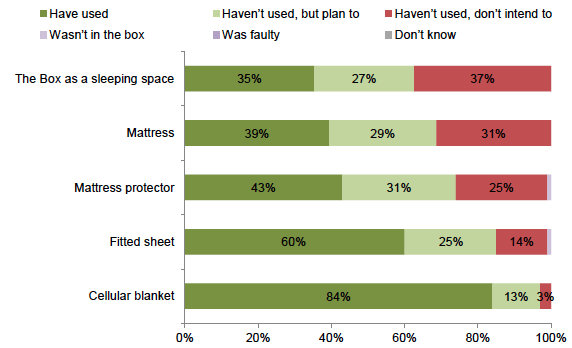
Base (All): 204
Experienced parents were more likely than first time parents to have used the box for their baby to sleep in (45% vs 26%), while first time parents were more likely to say they did not intend to use it as a bed (45% vs 30%). A similar pattern was seen for the mattress and mattress protector.
Those in the higher socio-economic groups were more likely to say they did not intend to use the box as a bed (43% of ABC1s, vs 26% of C2DEs).
Reasons for not using the box as a sleeping space
Any respondents who said they did not intend to use the box as a sleeping space or the bedding items were asked the reasons for this. The most common reason for not using these items was that respondents had already bought something similar (74% for bed; 81% for bedding), or that they had received something similar already as a gift (12% bed, 16% bedding). Just under one in ten (8%) said they did not want their baby to sleep in a box (see Figure 2).
Please note that the proportion reporting that they had already bought something similar could be related to the phased delivery time of the roll-out of the Baby Box scheme nationally. Now the programme is beyond the first cohort, recipients are more likely to be aware of what they will receive at an earlier time.
Figure 2: Reasons for not using the box as a sleeping space
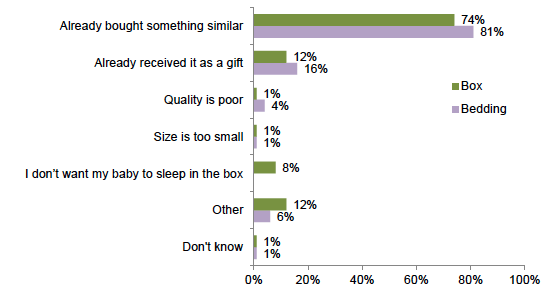
Base (All who do not intend to use): Bed: 76, Bedding 69
While numbers are very small, higher socio-economic groups were most likely to say they had already bought similar bedding items (88% of ABC1s vs 61% of C2DEs).
Nine people mentioned an ‘other’ reason for not using the box as a bed – 3 of these mentioned concerns about safety and 3 said they had pets which made them wary of using the box. For example:
“I have pets so don’t want to put the box on the floor”.
“I don’t know if it is safe”.
“It’s a bit deep, we have a crib that’s a bit shallower”.
“We have a dog and don't want him getting in there with the baby”.
Use of clothing
Overall, clothing items provided in the Baby Box were extremely well used (see Figure 3). Unsurprisingly given the sample dates (i.e. only one respondent had a baby born before August), the most used items were those for newborns. Items designed for 3-6 month old babies were less likely to have been used, but most intended to use these in the future. Taken together, the proportions reporting that they had used or planned to use each item were very high [6] :
- Long-sleeved vest (0-3 months) (98%)
- Long-sleeved sleep suit (0-3 months) (98%)
- Long-sleeved sleep suit (3-6 months) (98%)
- Fleece jacket with hood (3-6 months) (98%)
- Pair of socks (0-3 months) (97%)
- Pair of socks (3-6 months) (97%)
- Jersey trousers (3-6 months) (96%)
- Jersey trousers (0-3 months) (95%)
- All-in-one day suit (0-6 months) (95%)
- Short-sleeved vest (newborn) (94%)
- Long-sleeved vest (newborn) (94%)
- Cotton hat (0-3 months) (92%)
- Long-sleeved side buttoning vest (newborn) (89%)
- Scratch mittens (newborn) (89%).
The clothing items with the highest proportion saying they did not intend to use them were:
- Scratch mittens (newborn) (10% did not intend to use these)
- Long-sleeved side buttoning vest (newborn) (8%)
- Cotton hat (0-3 months) (8%).
Figure 3: Use of clothing
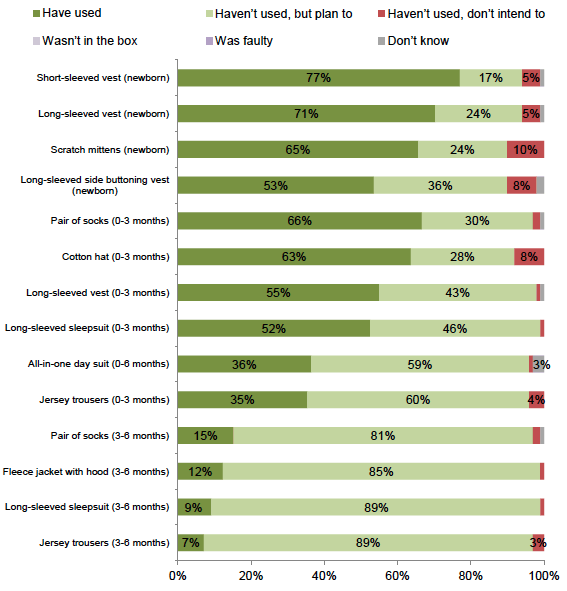
Base (All): 204
Reasons for not using clothing
Only 42 people said they did not intend to use one of the items of clothing. The most commonly mentioned reason for this was that the size was too small, they just didn’t like them or that they already had the item (bought themselves or received as a gift) – see Table 4.
Table 4: Reasons for not using clothing
| |
No. |
|---|---|
| Size is too small | 19 |
| Don’t like them/not the way I would dress my baby | 7 |
| Already received it as a gift | 5 |
| Already bought it | 3 |
| Quality is poor | 2 |
| Other | 11 |
Base (All who do not intend to use): 42
A range of ‘other’ reasons were given, although by small numbers of people. Some commented that clothing items were too big (or the baby was too small) and they were not sure whether they intended to use them in future. Two people also commented that they looked like girls clothing or were too feminine, rather than being unisex.
Equipment
The equipment included in the Baby Box was also very well used overall (see Figure 4). The muslin cloth squares and hooded bath towel were most popular, although all items had a high level of reported use/planned use. The proportions who had used/planned to use each item were [7] :
- Muslin cloth squares (100%)
- Baby books (100%)
- Hooded bath towel (99%)
- Bath sponge (99%)
- Bib (99%)
- Digital ear thermometer (98%)
- Teething ring soother (98%)
- Play mat (98%)
- Bath and room thermometer (97%)
- Travel changing mat (97%)
- Comforter toy (96%)
- Emery boards (95%)
- Pack of disposable nursing pads (89%)
- Pack of 12 maternity towels (86%)
- Baby wrap/sling (84%)
- Box of 3 condoms (79%).
The items with the highest proportion saying they did not intend to use them were:
- Box of 3 condoms (19% did not intend to use these)
- Baby wrap/sling (15%)
- Pack of 12 maternity towels (13%)
- Pack of disposable nursing pads (11%).
The thermometers were the only items to be reported as being faulty by a small number of people (two people had faulty bath/room thermometers, one had a faulty digital ear thermometer). None of these respondents had tried to get a replacement.
Figure 4: Use of equipment
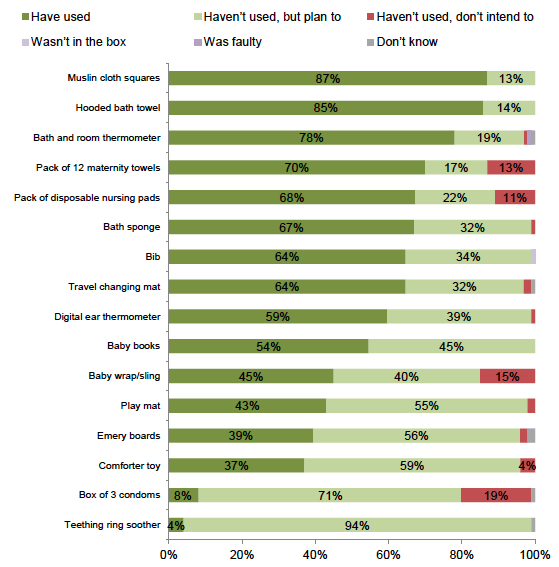
Base (All): 204
First time parents were more likely than others to have used the maternity towels (77% had used them vs 62% of experienced parents; 19% of experienced mums did not intend to use them vs 8% of first timers). Those in the most deprived areas were most likely to say they did not intend to use the condoms (33%, vs 16% of those in the least deprived areas).
Reasons for not using the baby wrap/sling
Thirty-one people said they did not intend to use the baby wrap/sling. Reasons for this were:
- I don’t need it (13 of the 31 respondents gave this reason)
- Already received it as a gift (6)
- Find it complicated/hard to use (4)
- Already bought it (3)
- Don’t feel comfortable using it (2)
- It was too big (1)
- Have a different type of carrier (1)
- Have twins so can’t carry both babies in it (1).
When asked if another type of wrap or carrier would be more useful, people generally found it difficult to come up with suggestions and very few made specific requests. The most common responses were:
- No or don’t know (15 of the 31 respondents said this)
- No, I just don't like these/prefer to use pram/buggy (5)
- No, I already have one (2)
- One that's easier to work/put baby in (2)
- Harness type (1)
- Ring sling (1)
- Double wrap sling (1)
- A smaller one (1)
- Different fabric (1)
- Over the shoulder type (1).
For example, comments included:
“I don’t like them personally, if you fall and your baby’s on your front, [it] seems dangerous”.
“No, the one included is fine, I just have others from previous child”.
“One that is easier to work, maybe a different style”.
“I prefer to walk the baby in a pram”.
Reasons for not using other equipment
Those who did not intend to use at least one item of equipment were mostly likely to say that this was because they had already bought it (30%) – see Figure 5. Some mentioned items being too small (16%) and 14% just said they didn’t need it, while one in ten (11%) had received the item as a gift. Very few mentioned poor quality as being the reason (7%).
Figure 5: Reasons for not using other equipment
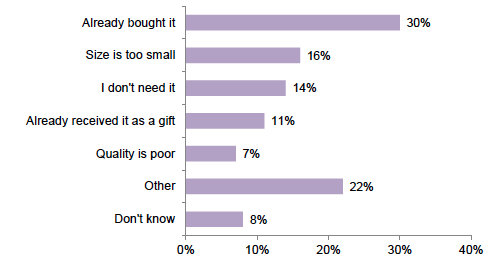
Base (All who do not intend to use): 76
Those giving an ‘other’ reason were most likely to mention:
- The baby being too small (11 of the 17 respondents said this – again these respondents were not sure if they would use the item in future so were not coded as ‘plan to use’)
- They do not use condoms in general (2)
- The room and bath thermometer was faulty (1)
- The pads are a bit too big (1)
- Issues with quality (1 respondent said that the cellular blanket is made from synthetic fibres and they would prefer cotton).
3.2 Ratings of items used
Respondents were asked, for each category of item they had used, how useful they found each type of product. Ratings of usefulness were very good (see Figure 6). Among those who had used each category of item, proportions saying they found items very or quite useful were:
- Equipment: 99% (83% said very useful)
- Clothing: 98% (76% said very useful)
- Bedding: 92% (65% said very useful)
- Baby wrap/sling: 89% (74% said very useful)
- The box as a sleeping space: 88% (64% said very useful).
Figure 6: Ratings of items used
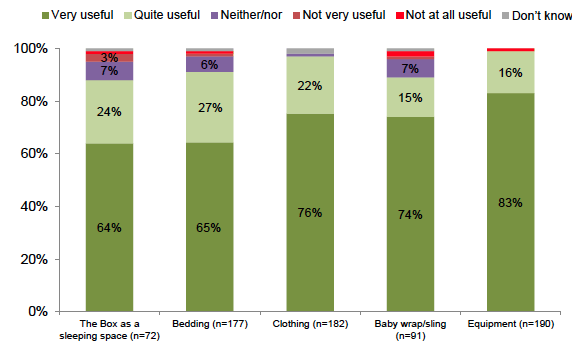
Base (All who had used items in each category): noted in chart
Most useful items
After rating each category of item, repsondents were asked an open ended question as follows: “Overall, which item that you have used did you find most useful and why?” Verbatim responses to this question were coded and the main categories of response are outlined in the following tables. As shown in Table 5, the most popular items were the bath/room thermometer and the digital ear thermometer, followed by the wrap/sling.
Table 5: Most useful items
| |
% |
|---|---|
| Bath/room thermometer | 32% |
| Ear thermometer | 22% |
| Sling/wrap/baby carrier | 15% |
| Clothes | 8% |
| Muslin cloths | 8% |
| Changing mat | 6% |
| Blanket | 5% |
| Box – for sleeping | 5% |
| Everything/all useful | 4% |
| Towel/hooded towel | 3% |
| Mattress/bedding | 3% |
| Box – no specific reason given | 2% |
| Box – as a handy space/extra space | 1% |
| Maternity pads | 1% |
| Fleecy jacket/hoodie | 1% |
| Bath sponge | 1% |
| Play mat | 1% |
| Comforter toy | 1% |
| Not sure/don't know/too early to say | 2% |
Base (All who had used any item): 190
The main reasons for selecting items as being useful were the fact they were easy to use/helpful to parents, they use them regularly, and/or that they didn’t have or wouldn’t have thought to get the item themselves (see Table 6).
Table 6: Reasons for this being the most useful
| |
% |
|---|---|
| Ease of use/helpful/convenient for parent | 32% |
| Frequency/regularity of use/use daily/all the time | 32% |
| Didn’t have/didn’t think of getting | 20% |
| Quality/warmth etc | 8% |
| Baby likes/helps sleep/settle | 6% |
| Cost/saving money/wouldn’t have bought | 5% |
| Need lots | 3% |
| Can use for other kids | 2% |
| Clever/useful idea | 1% |
Base (All who identified an item and gave a reason): 153
Feedback in relation to this question included comments such as:
“The room and bath thermometer as I wouldn't have thought about buying one and it is used daily”.
“Baby sling – I have been able to try the technique without having to spend a lot of money on a branded item”.
“The wrap is the best thing in the box especially as to buy is around £50, so it’s great to be included”.
“Maternity pads as I did not realise I would need so many”.
“The baby carrier/sling, it frees my hands because the baby always wants to be held”.
“Bath thermometer, so simple and easy to use and I wouldn't have thought to buy one”.
“The box itself with the mattress, the mattress is better than the one with the Moses basket”.
“Blanket as I use it all the time and it is a good size”.
“The hooded towel – really soft, warm and easy”.
“Fleecy jacket, will use the most often and is expensive to buy”.
“Box itself – it’s a great space to sleep, [the baby] settled well”.
“The baby box as a sleeping place is very useful, and the changing mat and equipment were very helpful”.
“The sling, it’s all been brilliant but that was very handy”.
3.3 Use and ratings of information provided
Information provided in the Baby Box was read by most respondents: at least eight in ten respondents had already read each of the listed reading materials (see Figure 7) and the proportions saying they had read or planned to read each item were as follows:
- A poem for your wee one (97%)
- Information on safe sleeping (93%)
- Information on postnatal depression (88%)
- Information on breastfeeding (84%).
Around one in ten (9%) said they did not intend to read the information on postnatal depression, and 14% said they did not intend to read the information on breastfeeding.
Figure 7: Use of information
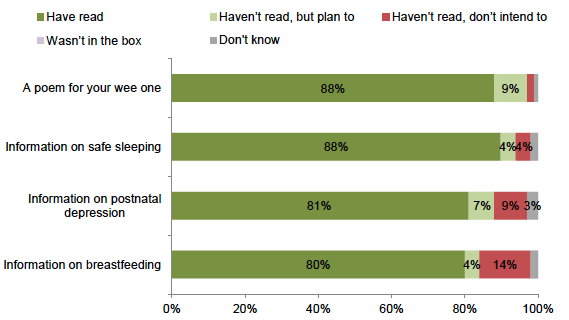
Base (All): 204
Experienced parents were more likely than first time parents to say they had not read the breastfeeding information and did not intend to (21% vs 8%). They were also more likely to say they did not intend to read the safe sleeping information (8% vs 1%).
Reasons for not reading information
Reasons given for not reading the information on breastfeeding centred on not wanting to breastfeed, or having received the information from elsewhere. Respondents who did not read the safe sleeping information said this was because they knew about it already or had received information from other sources. However, it should be noted that this is based on very small numbers, since most had read the information provided (see Table 7).
Table 7: Reasons for not reading information on breastfeeding or safe sleeping
| |
No. |
| Breastfeeding information | |
| I do not want to breastfeed | 11 |
| Have been given advice by healthcare professionals | 9 |
| Have seen information elsewhere | 8 |
| Already know about it from having other children | 7 |
| Have been given advice by friends/family | 2 |
| Don’t know | 1 |
| Safe sleeping information | |
| Already know about it from having other children | 5 |
| Have seen information elsewhere | 3 |
| Have been given advice by healthcare professionals | 2 |
Base (All who did not intend to read): Breastfeeding: 29, Safe sleeping: 9
Ratings of information
Ratings of the information provided were generally high, particularly for the safe sleeping information: 83% of those who had read it said it was very (49%) or quite (34%) useful (see Figure 8). Ratings were very slightly lower for breastfeeding information, although three quarters (76%) still judged it to be very or quite useful. Very few rated either of these types of information as being not very or not at all useful.
Figure 8: Ratings of information on breastfeeding and safe sleeping
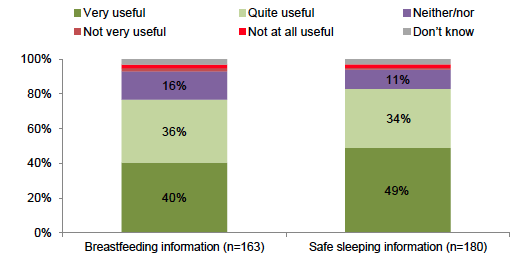
Base (All who had used information): noted in chart
Most comments about the information provided were positive, highlighting that it was useful/informative and easy to understand. The only slightly negative feedback received about the information was that respondents had already received it from other sources (e.g. midwives or antenatal classes). A small proportion (6%) said they were not breastfeeding/were not planning to breastfeed, so this information was not useful to them. See Table 8.
Table 8: Reasons for ratings of breastfeeding or safe sleeping information
| |
|
% |
|---|---|---|
| Breastfeeding information | ||
| Positive | Useful/informative info in general | 28% |
| Good refresher/reminder | 16% | |
| Handy to have/refer to | 15% | |
| Provided new information | 11% | |
| Easy to read/understand/clarity of info | 4% | |
| Negative | Already know/got info from elsewhere | 23% |
| Not planning to/not breastfeeding | 6% | |
| Safe sleeping information | ||
| Positive | Well-presented/easy to understand/clear | 21% |
| Good refresher/reminder | 16% | |
| Handy to have/refer to | 16% | |
| Provided new information | 14% | |
| Good for first time parents | 4% | |
| Useful to know about sleeping positions | 4% | |
| Negative | Already know/got info from elsewhere | 18% |
Base (All who had read info: Breastfeeding: 163, Safe sleeping: 180
3.4 Overall satisfaction
Reflecting the high levels of use and ratings of the items and information provided in the Baby Box, satisfaction levels were extremely high (see Figure 9). The overwhelming majority said they were very satisfied with all aspects of the Baby Box. Percentages saying they were very or quite satisfied were as follows:
- Overall quality of box and contents: 100% (95% were very satisfied)
- Range of items included: 99% (97% were very satisfied)
- Presentation and design of box: 99% (95% were very satisfied)
- Delivery arrangements: 99% (92% were very satisfied).
Figure 9: Satisfaction with the Baby Box
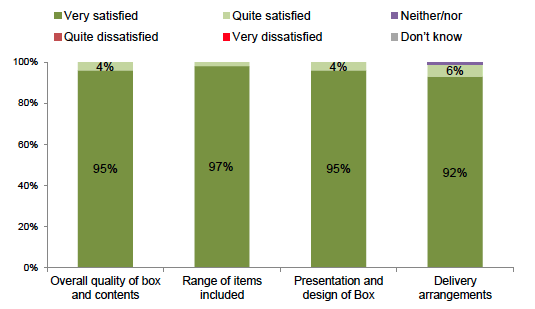
Base (All): 204
The lower socio-economic groups were more likely to say they were very satisfied with the delivery arrangements for the Baby Box (98% of C2DEs were very satisfied, vs 89% of ABC1s), although there was no difference in the proportion who were satisfied overall (very/quite satisfied).
Issues with quality
Very few respondents had any issues with the quality of any items in the box or the box itself [8] . The most common criticisms related to the quality of the maternity pads, which were judged to compare unfavourably to other products available, and issues with the bath/room thermometer. All other issues were raised by 2% of respondents or fewer (see Table 9).
Table 9: Issues with quality of any items in the Baby Box
| |
% |
|---|---|
| No issues/problems | 82% |
| Quality of maternity pads | 5% |
| Quality of/broken bath and room thermometer | 3% |
| Other item damaged/poor quality | 3% |
| Fabric composition of blanket | 2% |
| Clothing design | 2% |
| Issues with box or lid | 1% |
| Nursing pads not necessary | 1% |
| Other comment | 1% |
Base (All asked the amended question): 153
Feedback about quality included comments such as:
“The cellular blanket should be a more natural fabric”.
“Bath thermometer wont turn on”.
“Found the maternity pads to be a bit low on quality and they rustled when walking”.
“Maternity pads a bit inferior to branded makes”.
“The bath/room thermometer was broken and failed to work”.
“Cotton blanket as opposed to polyester”.
“The baby sling, the seam was torn when it arrived”.
“Bath towel is already a bit threadbare”.
“The changing mat – could not be washed could only be sponge cleaned”.
“Bath thermometer was the most useful item, but let down by poor quality battery cover”.
3.5 Proposed additions to the Baby Box
When asked spontaneously what, if anything, was missing from the Baby Box, the majority (69%) could not think of any suggestions. The most common request, made by 10%, was for newborn nappies to be included, and 4% mentioned reusable nappies specifically. All other suggestions were made by relatively small numbers (see Table 10).
Table 10: Suggested items that would have been useful
| |
% |
|---|---|
| No suggestions | 69% |
| Newborn nappies | 10% |
| Breastfeeding equipment (e.g. pump, nipple cream, nursing top) | 6% |
| Reusable nappies | 4% |
| Different clothes items (including different sizes/styles) | 3% |
| Information/resources/equipment for bottle feeding | 2% |
| Information and/or instructions for contents | 2% |
| Ability to donate | 1% |
| Dummies | 1% |
| Other misc. suggestions | 6% |
Base (All): 204
Suggested additions to the Baby Box included:
“Links to videos of how to use the sling, and newborn nappies”.
“Babies grow out of clothes really quickly, was expecting info for a bank/recycle platform”.
“Voucher for feeding support such as nursing bra”.
“Info on bottle feeding, some people are unable to breastfeed so are at a loss”.
“Birth sized nappies and sudocrem, breast pump and bottle”.
“Bigger range of sizes, boy/girl clothes”.
“Information on bathing your baby”.
“All in one newborn jacket”.
“A pack of newborn nappies”.
“Sling instructions as we had none”.
When prompted with potential additions to the Baby Box and asked how useful they would be, the most popular ideas were a second sheet for the mattress (67% said this would be very or quite useful), or vouchers for reusable nappies (62%) – see Figure 10. There was less support for additional information to help support breastfeeding (respondents tended to say ‘neither/nor’ for this suggestion), although a substantial minority (44%) would find additional equipment to help with breastfeeding very or quite useful.
Figure 10: Views of proposed additions to the Baby Box
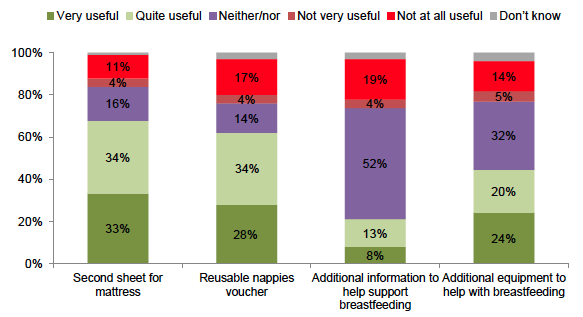
Base (All): 204
Additional equipment to help with breastfeeding was more likely to be mentioned as being very useful by ABC1s (29%) than C2DEs (15%), although there was no difference in the proportion saying it would be useful overall (very/quite useful).
Additional information or equipment to help with breastfeeding
Respondents who said that information or equipment to help with breastfeeding would be very or quite useful were asked to specify what sort of information or equpiment would be helpful.
Few people could identify specific information to help with breastfeeding. The most common suggestions were:
- Where to get support, or contacts for support groups (suggested by 8 people)
- More information about latching on (3)
- Hints and tips (3)
- Information about expressing/pumping/storage (2)
- Vouchers/breastfeeding equipment (2)
- Images (1).
The most frequently suggested additional equipment to help with breastfeeding were:
- Breast pump or voucher for pump (suggested by 49 people)
- Other equipment such as scarf, nipple shields, bottles, sterilizer bags (26)
- Nipple cream (22)
- Information/resources e.g. web links explaining types of pump etc. (3)
- Information about/voucher for hiring a pump (2).
3.6 Communications about the Baby Box
Findings about the Baby Box communications should be read in the context of the roll-out of the scheme across Scotland. It is important to bear in mind that survey respondents may not have received all of the communications – the survey sample was drawn from the first cohort to receive the box nationally and some communications were sent out later than would be normal now that the programme is fully rolled out.
Respondents were asked how they had first heard about the Baby Box scheme: the most common responses were on the news (41%) or from a midwife (30%). A further fifth mentioned online sources (21%) – see Figure 11.
Figure 11: Where respondents first heard about the Baby Box scheme
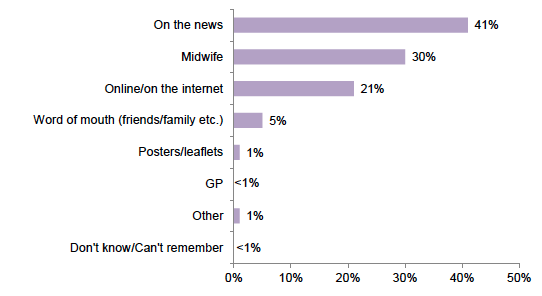
Base (All): 204
Recall of communications about the Baby Box was varied (see Figure 12). When asked which communications they had received, most respondents (87%) remembered getting a leaflet at their first midwife appointment but fewer mentioned the Baby Box leaflet despite it being in the box (61%) and just over half mentioned the registration card (53%). A fifth said they had been directed to the Parent Club website (23%).
Figure 12: Communications received about the Baby Box scheme
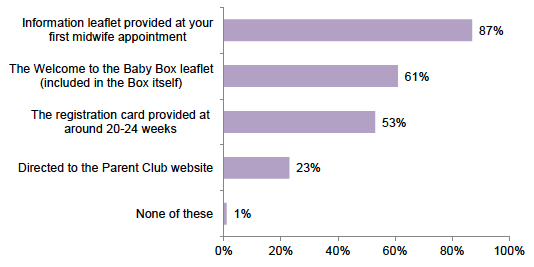
Base (All): 204
Experienced parents were more likely than first time parents to have heard about the scheme from a midwife (39% vs 22%), while first time parents were more likely to have heard about it on the news (49% vs 34%).
Respondents in socio-economic groups C2DE were more likely to have heard about the scheme on the internet (32% vs 16% of ABC1s), while ABC1s were more likely to have been made aware by the news (50% vs 24% of C2DEs).
Those living in the least deprived areas were more likely to mention the news (46%) than those in the most deprived areas (20%), while those in the most deprived areas were more likely to mention hearing about the Baby Box from a midwife (45% vs 27%).
Ratings of communications
Among those who remembered receiving communications, ratings of the information provided were very high (see Figure 13). The information leaflet from the midwife was rated as being most useful (66% said it was very useful, 29% said it was quite useful). Similar ratings were given to the registration card information and welcome leaflet, with around half saying these were very useful. Very few respondents gave negative ratings of any of the information provided.
Figure 13: Ratings of communications received
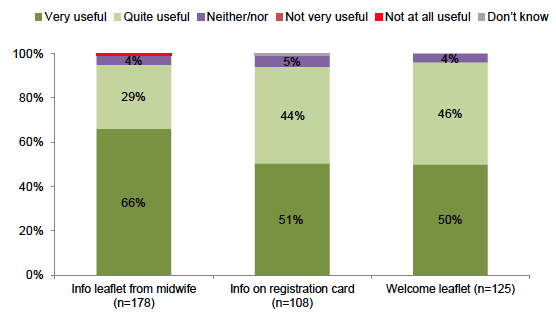
Base (All who had received communications): noted in chart
Improvements to communications
Reflecting the high levels of satisfaction with communications received, very few respondents suggested improvements: eight in ten (82%) did not make any suggestions (see Table 11). The most common request was to receive information about the Baby Box contents earlier on in the pregnancy, so that people could avoid purchasing items that were going to be in the box – 4% suggested this. All other suggestions were made by only a small number of people.
As noted earlier, issues being raised about the timing of information provision may have been affected by the fact that the sample was drawn from the first cohort of recipients; following the national roll-out recipients are more likely to be aware of what they will receive earlier in their pregnancy.
Table 11: Improvements to communication about the scheme
| |
% |
|---|---|
| No suggestions | 82% |
| Provide welcome leaflet/info on contents earlier | 4% |
| More info/promotion in general (making sure people are aware) | 3% |
| More info/communication from midwives | 2% |
| More info/clarity on delivery timing/date | 1% |
| Improve products | 1% |
| Info on donating items | 1% |
| Info in more languages | 1% |
| Info on external resources/help | 1% |
| Have a website/direct people to website | 1% |
| Option to choose which items you need | * |
| Other misc. comments | 2% |
Base (All): 204
Suggestions included:
“Provide information as to the contents of the box perhaps at time of registration (including photo)”.
“Directions towards additional support, e.g. local groups”.
“Give the welcome leaflet as early in pregnancy as possible to prevent buying included items”.
“As long as the midwife tells you then it should be fine”.
“A sheet with info links for breastfeeding and instructions on how to use the sling”.
3.7 The Parent Club website
As shown in Figure 14, a fifth of the sample overall (20%) said they had visited the Parent Club website. A quarter (25%) were aware of it but hadn’t used it. However, over half (54%) had not used it and were not aware of it. This level of use is in line with what was expected [9] .
Figure 14: Use of the Parent club website
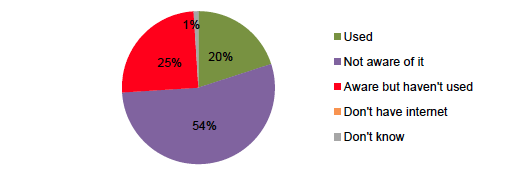
Base (All): 204
Comments on the website
Only 41 people had used the website, and 37 of these could not think of any content missing or information they couldn’t find. The only comments made were:
- Would be good to have a video instruction on how to put on the baby wrap
- A request for more local information
- A request for a chat facility
- Not a very user friendly way to find a list of the box contents.
Contact
There is a problem
Thanks for your feedback